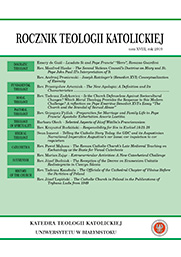The Influence of the Catholic Church in Cracow on the Cathedral Chapter of Vilnius from the Fifteenth through Eighteenth Centuries
The Influence of the Catholic Church in Cracow on the Cathedral Chapter of Vilnius from the Fifteenth through Eighteenth Centuries
Author(s): Tadeusz KasabulaSubject(s): Christian Theology and Religion, History of Church(es), Modern Age, 15th Century
Published by: Wydawnictwo Uniwersytetu w Białymstoku
Keywords: Catholic Church; Poland; Lithuania; Cracow; Vilnius; Diocese of Cracow; Diocese of Vilnius; cathedral chapter; cathedral; bishop; prelate; canon;
Summary/Abstract: Like the entire Diocese of Vilnius, the Cathedral Chapter of Vilnius drew considerably from the experience of the ecclesiastical environment of the Dio- cese of Cracow, which had already existed for four centuries when the Vilnius Chapter began and was establishing and organizing its own institutions and structures. Although the Diocese of Vilnius had remained part of the organi- zational structures of the ecclesial province of Gniezno from the beginning of the fifteenth century, it looked to Wawel and not to Wzgórze Lecha’s example. From the fourteenth century onward, Vilnius and Cracow were the capital cities of the Polish-Lithuanian state. For this reason, it was fitting that both of the dioceses, including their cathedral chapters, were organized, looked, and functioned similarly. When the local Church was being established and orga- nized in Lithuania, Cracow naturally served as a model for Vilnius because the local church in Cracow had already existed for more than four centuries and was, therefore, more organized, dynamic, and greatly exposed to the world in every respect than the ecclesiastical environment of Gniezno. This was also due to the fact that the Diocese of Cracow was at the center of royal power: it supported the throne of the Commonwealth directly; it sanctioned the court’s actions; it provided the monarch with expert and intellectual help necessary to conduct internal politics and engage in diplomacy. It is also significant that the person responsible for establishing the Church in Lithuania was, in fact, Lithuanian—King Władysław II Jagiełło was the first Jagiellonian to ascend the Polish throne. His successors continued his policies in the religious realm in Lithuania. It is not surprising, therefore, the Jagiełłoes were solicitous to ensure that Vilnius enjoyed the proper place in the hierarchy of Polish-Lithuanian dioceses under their jurisdiction in accordance with the belief that “Vilnius cannot stand out from Cracow.”The Lithuanian King Władysław II Jagiełło pro- vided materially for the Church in Vilnius, and he ensured that the capital of the Grand Duchy of Lithuania had the proper position within the structures of the Polish-Lithuanian state, which has becoming increasingly more integrated. Although the Diocese of Vilnius drew from the Diocese of Cracow’s example, it did not blindly imitate it. After it had been established and organized, the Vilnius Cathedral Chapter was able to develop its own models, unique identity, and manner of functioning as a completely self-sufficient corporation that no longer needed to refer so strongly to the model of Cracow.
Journal: Rocznik Teologii Katolickiej
- Issue Year: 20/2021
- Issue No: 1
- Page Range: 89-101
- Page Count: 13
- Language: English

